The Sabrent Rocket Q4 is an NVMe SSD that leverages the new PCIe 4.0 interface and is the latest model to be reviewed from the company’s Rocket line (the others being the Sabrent Rocket PCIe Gen4 and Sabrent Rocket PCIe Gen3). Sitting in the middle of the bunch as far as performance and price go, the Rocket Q4 uses the M.2 2280 form factor and is based on QLC NAND Flash memory, the latter which means it is more cost-effective.
For performance, the 4TB Sabrent Rocket Q4 is quoted to deliver up to 4,700 MB/s read and 1,800 MB/s write when installed on a PCIe 4.0 compatible motherboard (right now, only AMD offers this support), otherwise, the drive will peak at 3,300 MB/s read and 3,300 MB/s write.
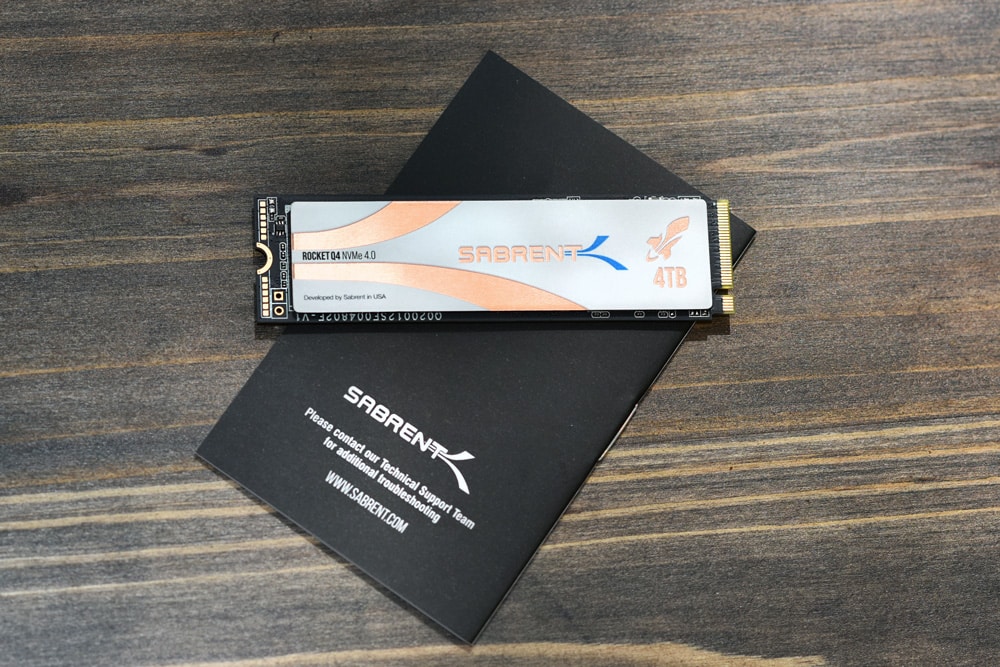
The Q4 supports SMART and TRIM commands as well as some reliability features such as Advanced Wear Leveling, Bad Block Management, Error Correction Code, and Over-Provision. The Sabrent drive also comes with downloadable software, including the company’s Sector Size Converter (SSC), which allows users to change the drive’s sector size, and Acronis True Image. Sabrent’s Control Panel is the usual proprietary SSD management software, which allows users to do things like check drive health, use secure erase, and upgrade firmware.
Backed by a 5-year warranty after registration (otherwise, one year), the Sabrent Rocket Q4 comes in capacities of 1TB ($220), 2TB ($440), and 4TB ($870). We will be looking at the highest capacity model for this review.
Sabrent Rocket NVMe PCIe 4.0 Specifications
| Interface | NVMe M.2 PCIe Gen4 x4
|
| Form factor | M.2 2280 |
| Model numbers |
|
| Capacities | 1TB, 2TB, 4TB |
| NAND | QLC NAND Flash memory |
| Performance | Sequential:
|
| Support | SMART and TRIM commands |
| Reliability | Advanced Wear Leveling, Bad Block Management, Error Correction Code, and Over-Provision |
| Weight | 2.4 oz |
| Warranty | 5-years after registration |
Sabrent Rocket Q4 NVMe PCIe 4.0 Design and Build
The Sabrent Rocket Q4 features a very nice silver and copper-colored sticker, which displays the company logo, product name, and drive capacity. It’s one of the nicer ones we’ve seen if that matters.
On the back is the usual sticker with detailed information about the drive, including serial numbers and certifications.
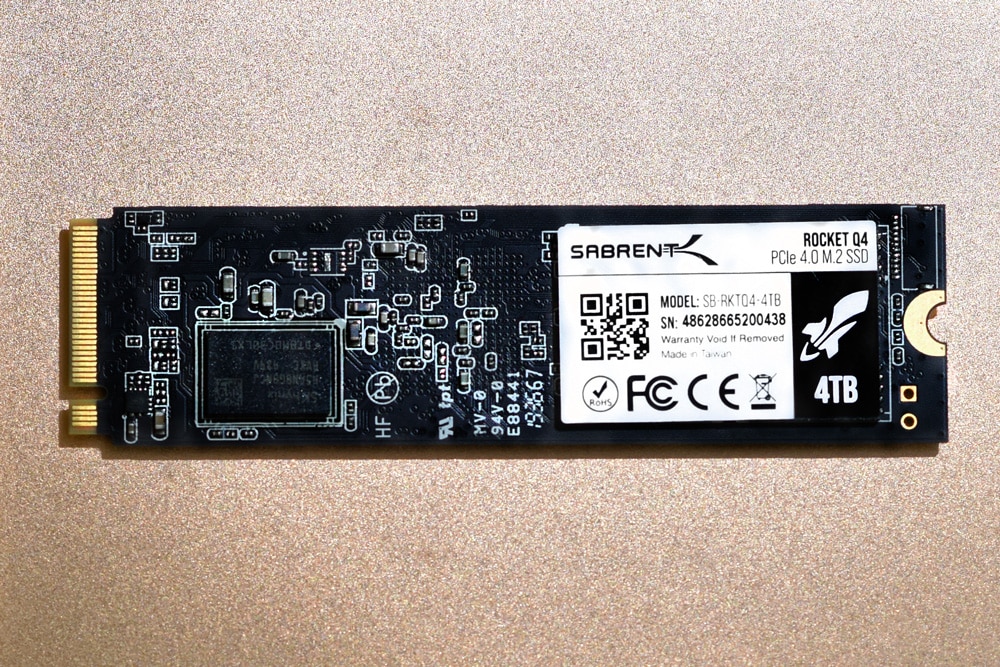
The Q4 also features a sizable, optional heat sink pad to keep it cool during heavy workloads, which helps to avoid performance throttling due to high thermal levels. Though it’s certainly not really necessary, it makes the drive look cool.
Sabrent Rocket NVMe PCIe 4.0 Performance
Testbed
As we migrate into testing newer NVME Gen4 SSDs, it required a platform shift in our lab to support the newer interface. Lenovo has been out in the front of the pack with PCIe Gen4 support, including up to the front-mount U.2 bays, while others still only offer edge-card support. In our Gen4 reviews, we leverage the Lenovo ThinkSystem SR635 server, equipped with an AMD 7742 CPU and 512GB of 3200Mhz DDR4 memory.
NVMe is tested natively through an M.2 to PCIe adapter card in the edge-card slot, while U.2 drives are loaded in the front. The methodology used better reflects end-user workflow with the consistency, scalability, and flexibility testing within virtualized server offers. A large focus is put on drive latency across the entire load range of the drive, not just at the smallest QD1 (Queue-Depth 1) levels. We do this because many of the common consumer benchmarks don’t adequately capture end-user workload profiles.
SQL Server Performance
Each SQL Server VM is configured with two vDisks: 100GB volume for boot and a 500GB volume for the database and log files. From a system resource perspective, we configured each VM with 16 vCPUs, 64GB of DRAM and leveraged the LSI Logic SAS SCSI controller. While our Sysbench workloads tested previously saturated the platform in both storage I/O and capacity, the SQL test is looking for latency performance.
This test uses SQL Server 2014 running on Windows Server 2012 R2 guest VMs, and is stressed by Quest’s Benchmark Factory for Databases. StorageReview’s Microsoft SQL Server OLTP testing protocol employs the current draft of the Transaction Processing Performance Council’s Benchmark C (TPC-C), an online transaction-processing benchmark that simulates the activities found in complex application environments.
The TPC-C benchmark comes closer than synthetic performance benchmarks to gauging the performance strengths and bottlenecks of storage infrastructure in database environments. Each instance of our SQL Server VM for this review uses a 333GB (1,500 scale) SQL Server database and measures the transactional performance and latency under a load of 15,000 virtual users.
SQL Server Testing Configuration (per VM)
- Windows Server 2012 R2
- Storage Footprint: 600GB allocated, 500GB used
- SQL Server 2014
- Database Size: 1,500 scale
- Virtual Client Load: 15,000
- RAM Buffer: 48GB
- Test Length: 3 hours
- 2.5 hours preconditioning
- 30 minutes sample period
Looking at SQL Server average latency, the Sabrent showed a solid average latency of 7ms, placing it in the middle of the pack.
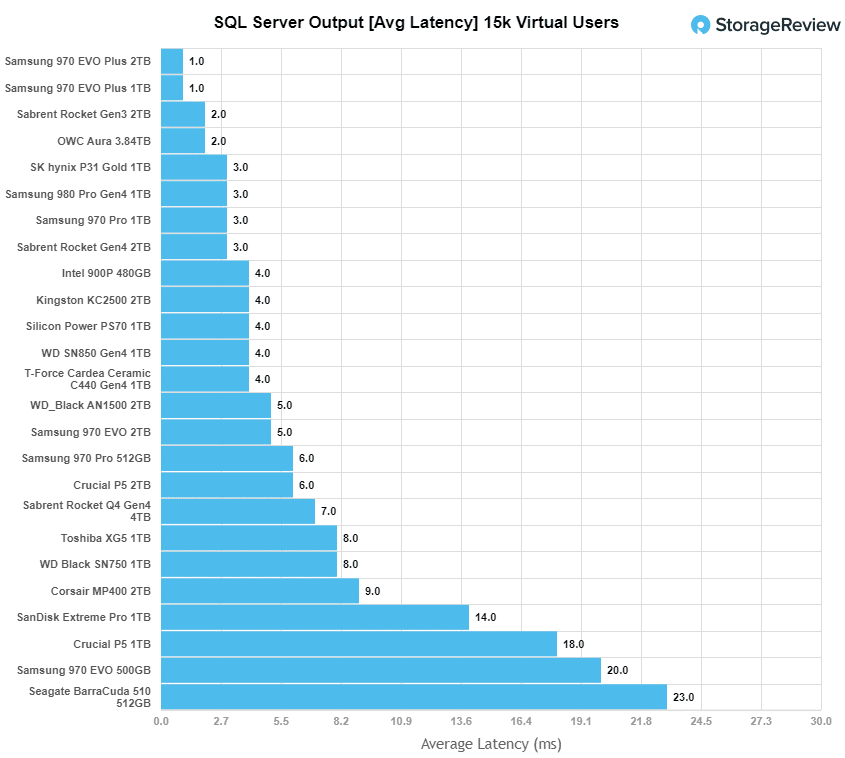
VDBench Workload Analysis
When it comes to benchmarking storage devices, application testing is best, and synthetic testing comes in second place. While not a perfect representation of actual workloads, synthetic tests do help to baseline storage devices with a repeatability factor that makes it easy to do apples-to-apples comparison between competing solutions. These workloads offer a range of different testing profiles ranging from “four corners” tests, common database transfer size tests, to trace captures from different VDI environments.
All of these tests leverage the common vdBench workload generator, with a scripting engine to automate and capture results over a large compute testing cluster. This allows us to repeat the same workloads across a wide range of storage devices, including flash arrays and individual storage devices. Our testing process for QLC SSDs starts with a secure erase, then we partition the drive to 1% of the drive capacity to simulate how the drive might respond to smaller application workloads. This is different from full entropy tests which use 100% of the drive and take them into steady state. As a result, these figures will reflect higher-sustained write speeds.
Profiles:
- 4K Random Read: 100% Read, 128 threads, 0-120% iorate
- 4K Random Write: 100% Write, 64 threads, 0-120% iorate
- 64K Sequential Read: 100% Read, 16 threads, 0-120% iorate
- 64K Sequential Write: 100% Write, 8 threads, 0-120% iorate
Comparables for this review:
In 4K random read, the Sabrent Q4 showed a peak of 363,347 IOPS with a latency of 178.4µs. Though it had similar IOPS and superior latency performance compared to the other drives during its peak, it took a sharp dip at the end, placing it behind the two PCIe 3.0 drives.
For 4K random write, the Q4 had the weakest performance of the bunch, with a peak of 193,251 IOPS at a latency of 657.2µs.
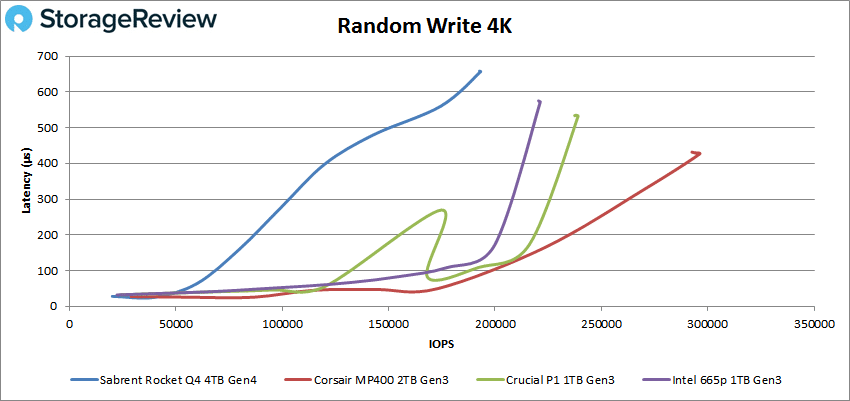
Switching over to sequential workloads, we first look at 64K read. Here, the Q4 had a peak of 56,917 IOPS or 3.56GB/s at a latency of 561.1µs before taking a slight dip at the end. This was good enough to take the top spot by a noticeable margin.

For writes, the Sabrent Q4 took the top spot again with a sizable lead, peaking at 59,470 IOPS or 3.71MB/s at a latency of 261.5ms.
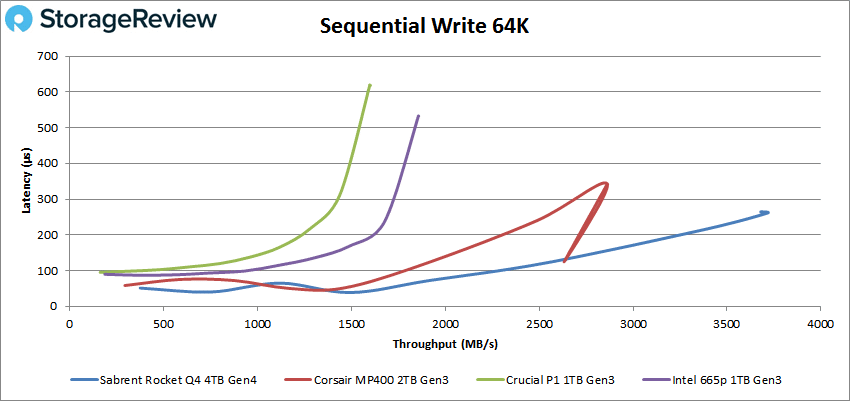
Next, we looked at our VDI benchmarks, which are designed to tax the drives even further. These tests include Boot, Initial Login, and Monday Login. Looking at the Boot test, the Sabrent Q4 showed similar performance as the Corsair drive (though showing a bit of instability at the end) with a peak of 88,472 IOPS at a latency of 368.4µs.
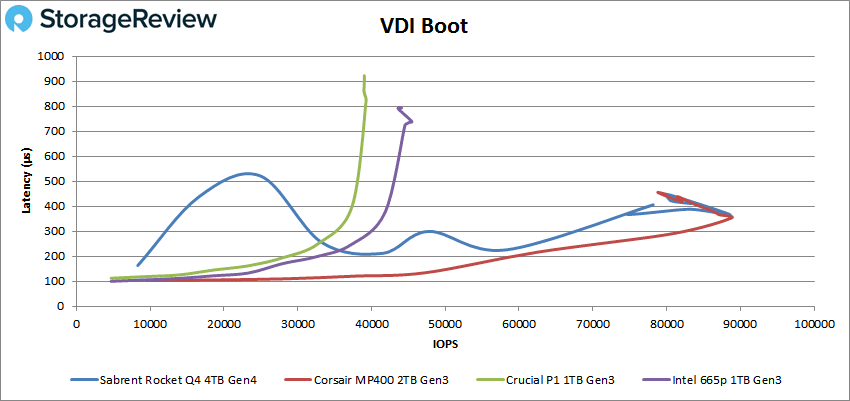
Though the Q4 showed the best peak performance by a significant margin (92,587 IOPS at 319.9µs) in VDI Initial Login, it became more unstable as the test went on.
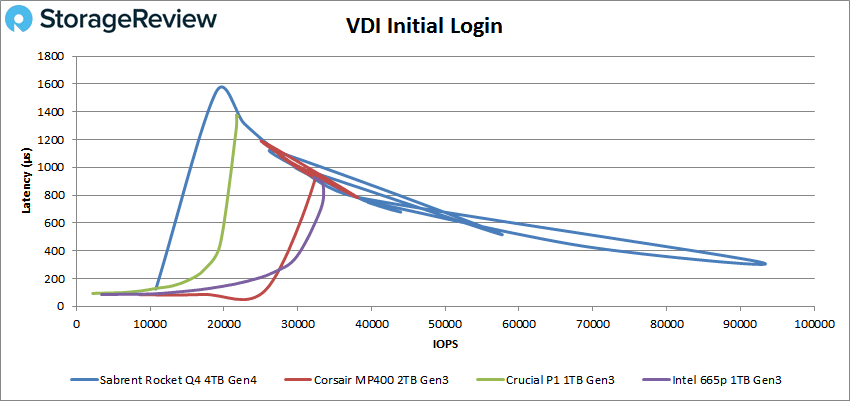
Our VDI Monday Login told a similar story, as the Sabrent had the best peak performance by mile with 47,495 IOPS at a latency of 333.7µs, before it showed a huge spike in performance immediately after.
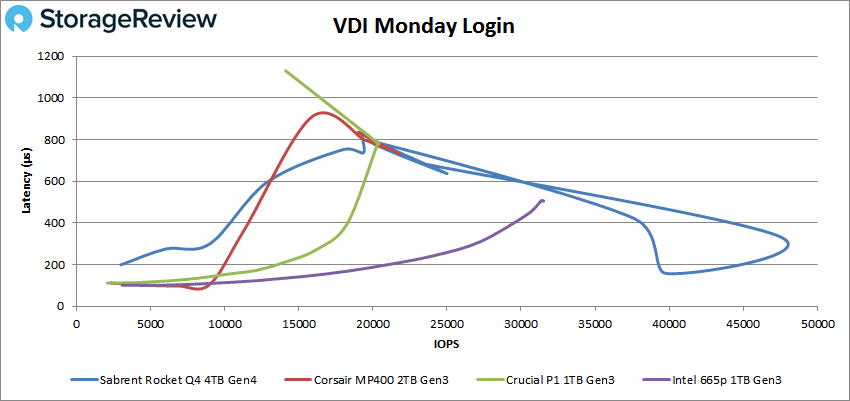
Conclusion
The Sabrent Rocket Q4 is an NVMe SSD that leverages the new PCIe 4.0 interface and QLC NAND Flash memory, all packed inside the small M.2 2280 form factor. Available in capacities up to 4TB, the Q4 is the last model from the Rocket line that we looked at.
Like the others (Sabrent Rocket PCIe Gen4 and Sabrent Rocket PCIe Gen3), the Q4 drive supports SMART and TRIM commands, as well as Advanced Wear Leveling, Bad Block Management, Error Correction Code, and Over-Provision technology. Moreover, the Rocket Q4 comes with software like Sector Size Converter, Acronis True Image, and the company’s proprietary SSD management software, the latter of which allows users to check drive health and upgrade the drive’s firmware.
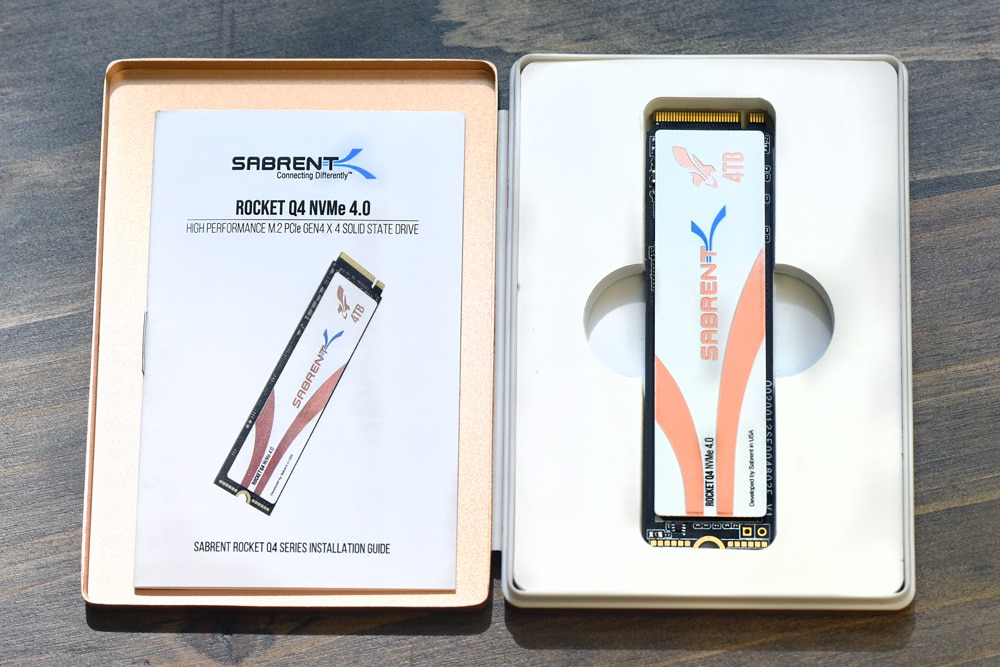
As for specifics of performance, the Q4 performed very well. First tested was the SQL Server benchmark, which gave us an average latency of 7ms. In VDBench, the Sabrent drive had peaks of 363,347 IOPS in 4K read, 4K write saw a peak of 193,251 IOPS, 64K read gave us 3.56GB/s, and 64K write saw the drive peak at 3.71MB/s.
For our VDI benchmarks, the drive hit a peak of 88,472 IOPS in boot, 92,587 IOPS in Initial Login, and 47,495 IOPS in Monday Login; though it had good peak scores in all VDI results, numbers showed some fairly big performance spikes.
Though we are seeing more and more Gen4 drives hit the market, performance still isn’t nearly where we want them to be, as the interface has the potential to double the performance of the previous generation. This is the case with the Sabrent Rocket Q4, which posted numbers more in line with high-end Gen3 consumer-grade drives (though results did keep within its quoted numbers from Sabrent, who indicated moderate sequential speeds). That said, we expect to see performance levels increase as we see more Gen4 drives in our lab, and as compatibility improves.
Overall, the Sabrent Q4 had good performance numbers, though its price point of $440 for the 2TB model will be pretty steep for most consumers. This is especially so when you compare it to the Corsair MP400, which is priced at around $290 with similar performance.


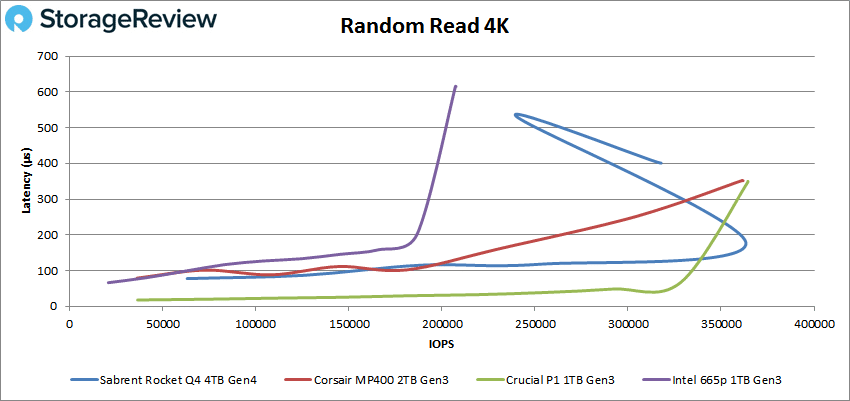


 Amazon
Amazon